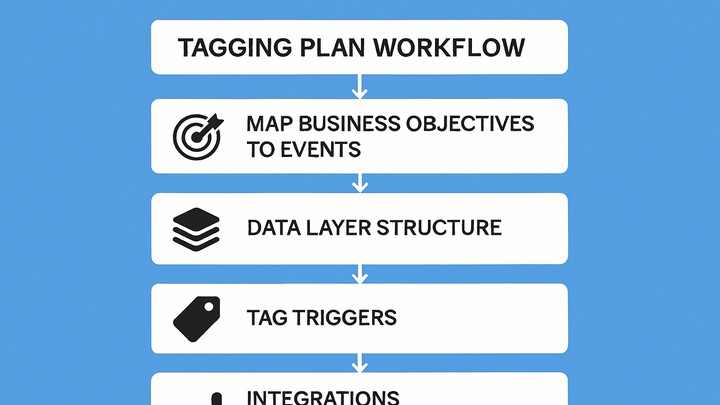Published on 2025-06-22T09:47:36Z
What is a Tagging Plan? Examples with PlainSignal & GA4
A Tagging Plan is a comprehensive blueprint for deploying and managing analytics tags, pixels, and event triggers across digital properties. It outlines which metrics to collect, the data layer schema, firing conditions, and implementation details for each tag. A well-designed tagging plan ensures that your analytics data aligns with business goals, maintains consistency, and reduces the risk of data gaps or redundancies. In the analytics industry, platforms like PlainSignal and Google Analytics 4 (GA4) rely on accurate tagging plans to deliver reliable insights. By planning your events, defining variables, and coordinating tag deployments in advance, you can streamline implementation, facilitate QA, and enable scalable growth. Whether you’re measuring pageviews, conversions, or custom interactions, a tagging plan serves as the central reference for your data collection strategy.
Tagging plan
Blueprint for deploying analytics tags and events to ensure consistent, goal-aligned data collection across digital properties.
Introduction to a Tagging Plan
An overview of what a tagging plan is and its role in analytics.
-
Definition
A tagging plan is a structured blueprint that outlines exactly which analytics tags (scripts and pixels) will be deployed across your website or app, when they should fire, and what data they should capture.
-
Purpose
It ensures consistency in data collection, aligns tracking with business objectives, reduces redundant tags, and facilitates accurate, reliable analytics reporting.
Key Components of a Tagging Plan
Breakdown of essential elements to include in your tagging plan.
-
Measurement plan alignment
Link your tagging plan to business goals by defining key performance indicators (KPIs) and mapping them to specific user interactions.
-
Data layer specifications
Define a consistent data layer schema with variables, event attributes, and structures that your analytics platforms will read and process.
-
Example data layer object
An example tailored to GA4 might look like:
window.dataLayer = window.dataLayer || []; window.dataLayer.push({ 'event': 'purchase', 'transaction_id': 'T12345', 'value': 99.99, 'currency': 'USD' });
-
-
Tag inventory
List all required tags, including analytics, marketing, and third-party scripts, along with their firing conditions and dependencies.
-
Governance & quality assurance
Establish processes for version control, tag testing, and periodic audits to maintain data integrity over time.
Implementation Examples
Sample code snippets showing how to implement your tagging plan with popular analytics platforms.
-
PlainSignal integration
To integrate PlainSignal (a cookie-free analytics SaaS), include the following snippet on every page you want to track:
<link rel="preconnect" href="//eu.plainsignal.com/" crossorigin /> <script defer data-do="yourwebsitedomain.com" data-id="0GQV1xmtzQQ" data-api="//eu.plainsignal.com" src="//cdn.plainsignal.com/plainsignal-min.js"></script>-
Placement
Insert within the <head> or just before the closing </body> tag to ensure proper loading without blocking page rendering.
-
Consent considerations
Since PlainSignal is cookie-free, it may simplify GDPR compliance, but still ensure alignment with your privacy policy.
-
-
Google analytics 4 integration
For GA4, implement tags using the Global Site Tag (gtag.js) and define your data layer:
<!-- Global site tag (gtag.js) - Google Analytics --> <script async src="https://www.googletagmanager.com/gtag/js?id=GA_MEASUREMENT_ID"></script> <script> window.dataLayer = window.dataLayer || []; function gtag(){dataLayer.push(arguments);} gtag('js', new Date()); gtag('config', 'GA_MEASUREMENT_ID'); </script>-
Event tracking
Use gtag(‘event’, ‘event_name’, { parameters }) to capture custom events aligned with your tagging plan.
-
Debugging
Google Tag Assistant and the Network tab help verify that events and tags fire as expected.
-
Maintenance & Governance
Strategies to keep your tagging plan accurate and up to date.
-
Regular audits
Schedule periodic reviews (e.g., quarterly) using tools like GA4 DebugView and PlainSignal dashboards to detect anomalies or missing events.
-
Change management
Document all tagging changes in version control and communicate updates to stakeholders to avoid tracking gaps or conflicts.
